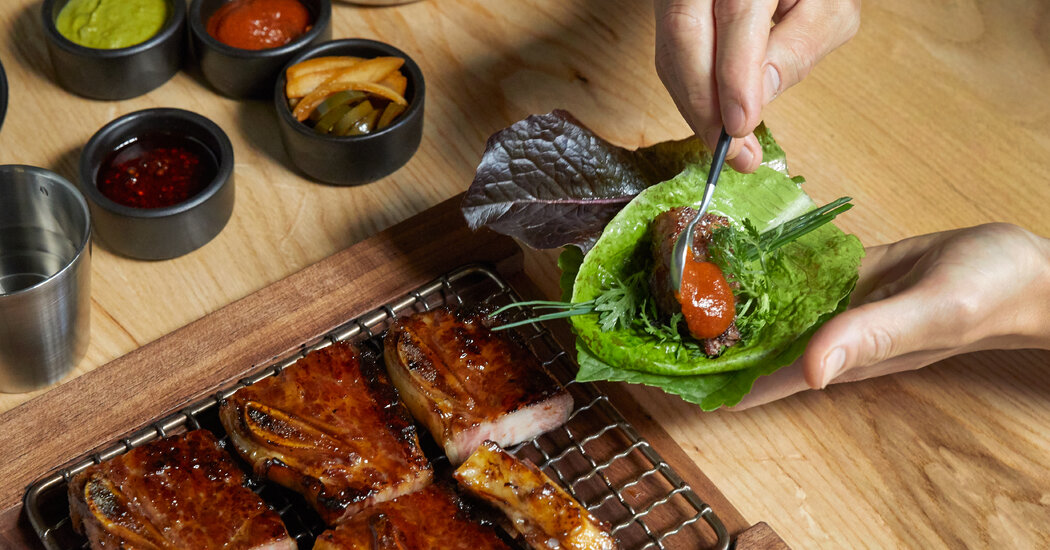
SAN FRANCISCO — Twenty years into running his restaurant in Los Angeles’s Chinatown, Yening Liang had a sudden moment of revelation.
It wasn’t enough, he realized, for the menus at Hop Woo to translate dishes like barbecue pork and roast duck from Cantonese into English. If he wanted the city’s Mexican, Central American and other Latino communities to feel welcome, he should include Spanish as well. When Mr. Liang, who was known as Lupe, died in May, his inclusive approach to menu writing became part of his legacy.
A menu can suggest an invitation, a blandishment, an obsession, but it’s never a mere catalog of what’s for dinner. Like any form of writing, it reveals countless small but significant decisions — what to expand and compress, what to blow up or evade, whom to address or freeze out, and how to direct a reader’s attention for the few, precious moments you might have it.
At San Ho Won, a Korean barbecue restaurant that Jeong-In Hwang and Corey Lee opened last November in San Francisco, the menu uses a combination of Korean characters, English transliteration and translation. A QR code acts as a footnote on the page, directing you to a glossary.
Some entries are quick synopses, like the one for jook: “rice porridge.” Others are finer-grained. An entry for jebi churi builds on the definition of the cut in Korean butchery, a slim piece of beef that “stretches from the upper rib to the neck” and, when viewed from a particular angle or sliced across, “resembles a swallow (jebi) in flight.”
If you didn’t know this before, jebi churi may now seem the only acceptable way to describe it — the name of the thing inextricable from its shape. And now that the lights are on, its English translation, “beef neck filet” does seem pretty clumsy, doesn’t it?
Here is a menu that insists on the need for a shared culinary language with more Korean terms, then proves their necessity. Sometimes, no other word will do. I was moved by this devotion to specificity even before I tried a bite of jebi churi and drifted away, marveling at its deliciousness.
Never mind the quality of your ingredients, or your marinade — barbecue like this doesn’t just happen, casually, right at the table, while you’re drinking beers and talking, looking up an actor’s name on your phone to settle an argument.
It requires both expertise and hypervigilance to keep time with the charcoal. In other words, it requires dedicated cooks. San Ho Won has about three working the grill in the kitchen on a busy night.
Tender, but resilient, thickly cut galbi, beef tongue, jebi churi and richer, fattier pieces of rib-eye cap are evenly colored and glossy, delicately crisp at their edges, impossibly juicy inside. The meat arrives hot and plump from the intense, glowing heat of the coals, enveloped in the deeply savory flavors you can only get from cooking this way.
Mr. Lee, the restaurant’s owner and the chef behind the fine-dining restaurant Benu, had been sitting on the idea for a casual Korean restaurant since 2012. But very few spaces will accommodate the building codes for a charcoal-fueled indoor kitchen in California, and he didn’t sign the lease on the sprawling, single-story space in the Mission district until 2019.
During the pandemic, Mr. Lee and Mr. Hwang, the restaurant’s chef, had even more time on their hands, but used it wisely, testing many of the dishes that now appear on San Ho Won’s menu and selling them as takeout.
It’s not just Mr. Hwang’s barbecue that shines, but also the smidges of sauces and pickles that season it, and the various styles of kimchi that accompany it — the sharp but juicy stuffed cucumbers, oi sobagi; and the cute, nearly bite-size chonggak, or ponytail radish.
One of my favorite things on the menu is the dainty, crisp-edged sanma pajeon, the pancake threaded with green onion and mountain yam, with its hyperbolized contrast of crisp and slippery. The jook, a rich rice porridge made with chicken, ginseng and abalone, drizzled with seaweed oil, is a luxurious, almost muscular flex.
Not cooking your own food at a Korean barbecue restaurant, or at least not sitting around the warmth of an open grill, might suggest a loss of the genre’s communal spirit. But the room has the comforting, informal clatter of a late-night place that’s been around for years — hectic, warm, efficient — with unflappable servers gliding quickly through the chaos, reorganizing it as they go.
Most of the food is served family-style to share, and tantalizing specials are simply written on pieces of paper, posted to the dining room’s thick wooden columns. You can order these — like a recent version of ganjang gejang made with marinated soft-shell crabs from Maryland and whole egg yolks — à la carte.
But don’t overlook the set meal, which is structured quite differently from a formal tasting menu. A recent version included juicy beef mandu in a crisp, shiny lacework, along with the big, wobbly egg soufflé, gyeran jjim, in a head-filling anchovy broth, served so hot that it warmed the gullet as it slid down.
The meal is a feast and the dishes aren’t paraded out one at a time, in individual portions, but rather in a continuing, overlapping sequence. The barbecue course will cheerfully interrupt the banchan, pancakes and dumplings. The last few bites of barbecue will scoot over to make room for jook, or pozole, and so on.
You’ll want to come back, to try everything, but this carefully edited slice of the menu is a good place to start.
San Ho Won, 2170 Bryant Street, San Francisco; 415-868-4479; sanhowon.com




